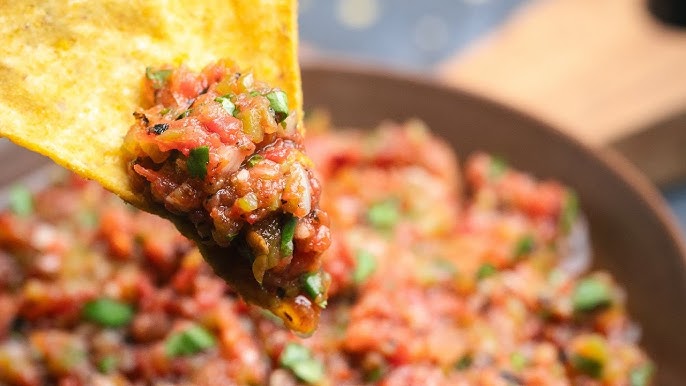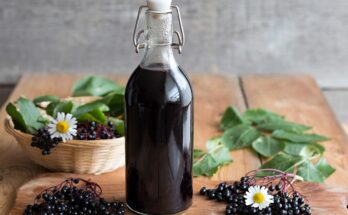Roasted Salsa Recipe: There’s something magical about a good roasted salsa—it’s smoky, spicy, tangy, and absolutely addictive. Whether you’re looking to impress guests at a party or just want to elevate your taco night, a homemade roasted salsa is a must.
This guide breaks everything down step by step, from the ingredients to the roasting and blending process, ensuring your salsa is packed with flavor and just the right amount of heat.
Ready to roast, blend, and dip? Let’s dive into the world of roasted salsa!
What is Roasted Salsa?
Roasted salsa, often referred to in Spanish as salsa asada, is a classic Mexican condiment made by roasting fresh ingredients like tomatoes, peppers, garlic, and onions until they’re beautifully charred. This charring process brings out deep, rich flavors that raw or boiled salsas simply can’t match. It’s the kind of salsa you dip your tortilla chips into and suddenly realize you’ve devoured the whole bowl.
The beauty of roasted salsa lies in its simplicity. With just a few humble ingredients and a little bit of heat (from the oven, grill, or stovetop), you can whip up a condiment that’s versatile enough to serve with breakfast eggs, grilled meats, or just as a dip for crunchy snacks. Unlike commercial jarred versions, homemade roasted salsa is free from preservatives and packed with fresh, bold flavor.
Why Roasting Makes a Difference
Roasting transforms the flavor profile of each ingredient. Tomatoes become sweeter and less acidic. Onions mellow out and take on a caramelized depth. Garlic becomes nutty and rich. Peppers, especially when slightly blackened, develop a smoky taste that gives the salsa its signature earthy kick.
Here’s the science: when you roast vegetables, especially at high heat, you trigger the Maillard reaction—a chemical process that browns the sugars and proteins, creating new, complex flavor compounds. That’s why roasted salsa tastes so much deeper than its raw or boiled counterparts.
Another bonus? Roasting softens the ingredients, making them easier to blend into a silky, luscious texture (or leave chunky, if that’s your jam). Whether you roast under the broiler, on a grill, or directly on a skillet, the payoff is huge in terms of flavor and authenticity.
List of Ingredients You’ll Need
Core Vegetables for Roasting
Here’s the foundation for a traditional roasted salsa that delivers both flavor and punch. These are the must-haves:
- Roma Tomatoes (4-6 medium): They’re firm, less watery, and roast beautifully.
- White Onion (1 medium): Brings a sweet, pungent undertone.
- Garlic Cloves (3-4 cloves): Adds a rich, aromatic depth.
- Jalapeño Peppers (1-2): For that signature spicy kick.
- Serrano Peppers (optional, for extra heat): A great way to amp things up.
- Salt (to taste): Enhances and balances all flavors.
- Fresh Cilantro (1 handful, chopped): For freshness and brightness.
- Lime Juice (1-2 limes): Adds acidity and zing.
These ingredients come together in a simple yet powerful way. They’re roasted until blackened in spots, then blended into a fire-roasted masterpiece.
Optional Add-Ins for Flavor Enhancement
Want to get creative? Here are some add-ins that can take your salsa to another level:
- Chipotle in Adobo Sauce: For a smoky, spicy vibe.
- Tomatillos: For a tart, green-style roasted salsa.
- Red Bell Peppers: For sweetness and color contrast.
- Cumin Powder: Adds an earthy, almost nutty flavor.
- Roasted Corn Kernels: For texture and sweetness.
These extras aren’t essential, but if you’re making salsa regularly, you’ll love experimenting with these flavor boosters.
Choosing the Right Peppers for Your Heat Level
The heat level of your salsa depends mostly on your pepper choices. Here’s a quick guide to help you control the burn:
| Pepper Type | Heat Level | Notes |
|---|---|---|
| Jalapeño | Mild-Medium | Popular, versatile, and flavorful |
| Serrano | Medium-Hot | Spicier than jalapeños |
| Habanero | Very Hot | Fruity flavor, extreme heat |
| Poblano | Mild | Smoky and earthy, great for roasting |
| Chipotle | Medium | Smoked jalapeño, deep flavor |
Pro Tip: Remove the seeds and membranes from your peppers to reduce the heat if you’re not a fan of spice bombs.
Essential Tools and Equipment
Kitchen Tools for Roasting
To get that beautiful char and deep flavor, you’ll need a few kitchen essentials:
- Baking Sheet or Cast-Iron Skillet: For roasting under the broiler or on the stovetop.
- Tongs: To flip veggies and get an even roast.
- Oven or Grill: Broiler setting works perfectly for indoor roasting.
- Foil or Parchment Paper: Makes clean-up easier.
If you’re roasting directly over an open flame (like on a gas stove), metal skewers or a wire mesh can also be helpful.
Blending and Storage Tools
Once your ingredients are roasted, you’ll need:
- Blender or Food Processor: For blending to your preferred texture—smooth or chunky.
- Glass Jars or Airtight Containers: For storing leftovers.
- Rubber Spatula: To scrape down the blender without wasting any salsa.
Bonus tip: If you’re blending hot roasted ingredients, vent the blender lid slightly or allow the veggies to cool a bit to avoid pressure build-up.
Step-by-Step Guide to Making Roasted Salsa
Step 1: Selecting Fresh Ingredients
The secret to great roasted salsa starts with the freshest produce. Choose ripe Roma tomatoes, fresh chilies (like jalapeños or serranos, depending on your heat preference), garlic cloves, onions, and a handful of fresh cilantro. Firm, vibrant vegetables give your salsa a natural sweetness and bold flavor after roasting.
Step 2: Roasting the Vegetables Perfectly
Preheat your oven to 425°F (220°C) or heat a cast-iron skillet for stovetop roasting. Arrange your tomatoes, onions, garlic, and chilies on a baking sheet and drizzle lightly with olive oil. Roast for 15–20 minutes, flipping halfway through, until the skins are blistered and slightly charred. This step caramelizes the natural sugars, adding depth and smokiness to your salsa.
Step 3: Blending the Roasted Mix
Let the roasted vegetables cool slightly, then transfer them to a blender or food processor. Add a handful of cilantro, a squeeze of lime juice, and a pinch of salt. Blend to your preferred texture — smooth for dipping or chunky for that rustic, homemade charm. You can add a splash of water if it’s too thick.
Step 4: Seasoning and Taste Adjustment
Taste your salsa and fine-tune the flavor. Add more salt for balance, lime juice for brightness, or an extra roasted chili for more heat. If it tastes too acidic, a tiny pinch of sugar can round out the flavor. This is your moment to make it uniquely yours.
Step 5: Cooling, Storing, and Serving
Once blended, allow your salsa to cool completely before serving or storing. For best results, refrigerate it for at least an hour to let the flavors meld together. Serve with tortilla chips, tacos, grilled meats, or even eggs. Store leftovers in an airtight container in the fridge for up to 5 days.
Smoky, tangy, and vibrant — this roasted salsa brings that authentic homemade flavor straight to your table.
Tips for the Best Roasted Salsa
Flavor Balancing Tricks
Even if you follow the recipe to a tee, a little extra balancing can make your salsa go from good to unforgettable. Here’s how you can tweak your batch for maximum flavor harmony:
Too Acidic?
- Add a tiny pinch of sugar or honey. This won’t make it sweet—it’ll just mellow the acidity.
- Roasting the tomatoes longer can also reduce harshness.
Too Salty?
- Add an extra roasted tomato or a bit of fresh tomato to dilute.
- A splash of unsalted tomato juice can also help tone it down.
Too Bitter?
- This can happen if garlic or peppers are over-charred.
- Add a squeeze of lime and a few fresh herbs like cilantro or green onion.
Too Bland?
- Crank up the flavor with more roasted garlic, an extra pinch of salt, or a spoon of chipotle in adobo.
- A tiny bit of olive oil stirred in can also help amplify mouthfeel and flavor richness.
Missing Depth?
- Try a touch of cumin or smoked paprika.
- A splash of soy sauce (yes, really!) can introduce that elusive umami.
Balancing your salsa is a game of small adjustments—taste constantly and tweak gently.
Texture Tips – Chunky vs Smooth
There’s no “right” texture—just your preference. But here’s how to control it:
Chunky Salsa:
- Use a food processor with pulse settings.
- Add onions and herbs after blending the rest.
- Mash slightly with a fork or potato masher if needed.
Smooth Salsa:
- Blend at high speed.
- Strain through a fine mesh sieve for restaurant-style smoothness.
- Add a bit of water to thin out thick blends without dulling flavor.
Pro Tip: Letting your salsa rest in the fridge for a few hours before serving will help flavors marry beautifully and improve both texture and taste.
Variations of Roasted Salsa
Roasted Green Salsa (Salsa Verde)
Salsa verde is made using tomatillos instead of tomatoes. It’s tangy, bright, and incredibly versatile.
Ingredients:
- 1 lb tomatillos, husked and rinsed
- 1 small white onion
- 2 cloves garlic
- 1-2 jalapeños or serranos
- Handful of cilantro
- Salt and lime juice to taste
Steps:
- Roast the tomatillos, garlic, onion, and peppers until charred.
- Blend with cilantro, salt, and lime.
- Adjust texture and flavor as described above.
It’s a perfect topping for grilled meats, tacos, enchiladas, and even eggs.
Spicy Roasted Salsa with Extra Heat
Love your salsa with a serious kick? Try this fiery version:
Ingredients:
- Add 1–2 habaneros or Thai chilies to your original mix.
- Include a spoonful of chipotle peppers in adobo.
- Roast everything deeply, until nearly blackened.
Be careful with the habaneros—they’re spicy and can overwhelm other flavors if used too liberally. Always remove the seeds and membranes unless you’re a true heat-seeker.
Smoky Chipotle Roasted Salsa
Chipotle adds a unique, deep smokiness with a medium level of heat.
Ingredients:
- 2 chipotle chilies in adobo
- 4 roasted Roma tomatoes
- 1 clove roasted garlic
- 1/2 roasted onion
- Splash of adobo sauce
- Cilantro and lime juice
Blend all and taste. You’ll get a salsa that’s perfect with grilled meats or BBQ, thanks to that earthy, smoky layer.
Serving Ideas
Roasted salsa isn’t just a dip—it’s a culinary sidekick that shines in so many ways.
What to Eat with Roasted Salsa
Here are just a few mouthwatering pairings:
- Chips and Dip: The classic. Serve it with warm tortilla chips or pita crisps.
- Tacos: Spoon it over carne asada, carnitas, or grilled veggie tacos.
- Egg Dishes: Drizzle over huevos rancheros, scrambled eggs, or frittatas.
- Grilled Meats: Roasted salsa is a natural complement to steak, chicken, or shrimp.
- Burritos and Bowls: Swirl into burrito bowls for extra flavor.
- Baked Potatoes: Try it in place of sour cream or butter.
- Burgers and Sandwiches: Use it as a condiment to replace ketchup or mayo.
Best Pairings for Every Occasion
- Game Day: Serve with nachos, sliders, or wings.
- Dinner Parties: Use as a topping for appetizers like stuffed mushrooms or crostini.
- BBQ Night: Pair with grilled ribs, smoked sausages, and charred corn.
- Brunch: Spoon it over avocado toast or top shakshuka for a tangy twist.
It’s truly one of the most adaptable condiments in your kitchen arsenal.
Storage and Shelf Life
Homemade roasted salsa is fresher and more flavorful than store-bought, but it doesn’t have the same preservatives. Here’s how to store it right:
Refrigeration Tips
- Store salsa in glass jars or BPA-free airtight containers.
- Use within 5–7 days for best flavor.
- Always use a clean spoon to serve—this extends shelf life by avoiding contamination.
- Label with the date and any spice-level notes.
Can You Freeze Roasted Salsa?
Yes! Freezing works great:
- Use freezer-safe containers or ice cube trays (then transfer cubes into a bag).
- It can be frozen for up to 3 months.
- Thaw in the fridge overnight or gently in a pan over low heat.
- Note: The texture might thin slightly after thawing, but a quick re-blend or stir can fix that.
Want to keep salsa long-term? Consider canning it using safe, approved methods and sterilized jars.
Common Mistakes to Avoid
Creating roasted salsa isn’t difficult, but a few common missteps can turn a great batch into a disappointing one. Here’s how to avoid them:
Over-Roasting or Under-Roasting
Over-roasting happens when veggies are burnt to the point of bitterness. A little char is good—too much ruins the flavor. If your garlic turns completely black or your tomatoes collapse into ash, you’ve gone too far.
Under-roasting, on the other hand, can result in a bland salsa. If your tomatoes are still firm or your peppers are raw inside, the full smoky potential hasn’t been unlocked. Aim for visible charring but a softened interior.
Tip: Roasting time varies based on size and ripeness. Watch closely, especially under a broiler where veggies can go from golden to burnt in seconds.
Not Balancing the Acidity
Salsa that’s too sour or flat often needs better acid control. Lime juice is powerful—start with a little, then add gradually. Too much lime can overpower the roasted flavors.
Also, tomatoes can vary wildly in acidity. Some batches may need more salt or a touch of sugar to balance the tartness. Taste, adjust, and taste again. Always.
Other mistakes:
- Using watery or overripe tomatoes.
- Skipping salt altogether.
- Not letting the salsa rest after blending—it needs time to settle.
Health Benefits of Roasted Salsa
Roasted salsa isn’t just tasty—it’s good for you, too. Packed with fresh vegetables, antioxidants, and metabolism-boosting peppers, it’s a condiment that delivers nutrition as well as flavor.
Nutrient Profile of Ingredients
Let’s break it down:
| Ingredient | Health Benefit |
|---|---|
| Tomatoes | High in vitamin C, lycopene (a powerful antioxidant) |
| Garlic | Supports immunity, anti-inflammatory |
| Onion | Rich in flavonoids, heart-healthy |
| Peppers | Boost metabolism, vitamin C rich |
| Cilantro | Detoxifying, high in antioxidants |
| Lime Juice | Aids digestion, immune support |
A two-tablespoon serving of roasted salsa has less than 20 calories, no added sugar, and virtually no fat.
Low-Calorie Flavor Boost
Using roasted salsa as a topping instead of sauces or dressings can reduce calorie intake significantly. Instead of ranch or mayo, try salsa on:
- Salads
- Grilled chicken
- Sandwiches
- Rice bowls
It’s flavorful, satisfying, and helps you stick to clean eating without feeling deprived.
FAQs about Roasted Salsa Recipe
1. Can I make roasted salsa without a blender?
Yes, you can use a mortar and pestle (molcajete) for an authentic texture, or finely chop all the ingredients for a rustic version. It takes more time but offers incredible flavor and presentation.
2. How spicy is traditional roasted salsa?
It varies based on the peppers you use. Jalapeños offer mild to moderate heat, while serranos and habaneros increase the spice level. You can control it by removing seeds or choosing milder chiles.
3. Can I use canned tomatoes instead of fresh ones?
You can in a pinch, but fresh roasted tomatoes offer a richer, deeper flavor. If using canned, opt for fire-roasted varieties and drain excess liquid before blending.
4. How long can I store roasted salsa in the fridge?
Roasted salsa lasts 5–7 days in the fridge when stored in an airtight container. Use a clean spoon each time to prevent spoilage.
5. Is roasted salsa healthier than store-bought?
Absolutely! Homemade salsa is free of preservatives, low in calories, and packed with nutrients. You also control the salt, spice, and flavor, making it far healthier and fresher than most store-bought versions.
Conclusion
There you have it—a full guide to making rich, smoky, irresistible roasted salsa at home. Whether you like it mild, spicy, chunky, or smooth, this recipe is endlessly customizable and always a crowd-pleaser.
From handpicking the freshest ingredients to mastering the art of roasting, every step adds a layer of flavor. And with a few optional add-ins and variations, you’ll never get bored.
So next time you reach for store-bought salsa—stop yourself. Fire up your oven or grill, grab those tomatoes and peppers, and create something bold, fresh, and entirely yours.



